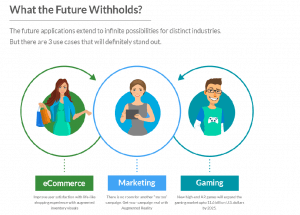
What is Augmented Reality?
With each step forward in the digital revolution, “The Matrix” becomes less like fiction and more like reality. That’s in part because hardware engineers and software developers continue to refine their augmented reality technologies, making the line between real and virtual life ever blurrier!
Augmented reality (AR), it seems, may soon be the true reality for us all.
Augmented reality systems show virtual objects in the real world. Augmented reality is the blending of interactive digital elements – like dazzling visual overlays, buzzy haptic feedback, or other sensory projections – into our real-world environments.
Have a look at this Augmented Reality video!
 The first big break for AR was the “Pokémon GO” game, released in 2016 with a feature that let players see virtual Pokémon standing in front of them, ready to be captured and played with. This (once incredibly popular) mobile game allowed users to view the world around them through their smartphone cameras while projecting game items, including onscreen icons, score, and ever-elusive Pokemon creatures, as overlays that made them seem as if those items were right in your real-life neighborhood. The game’s design was so immersive that it sent millions of kids and adults alike walking through their real-world backyards in search of virtual prizes.
The first big break for AR was the “Pokémon GO” game, released in 2016 with a feature that let players see virtual Pokémon standing in front of them, ready to be captured and played with. This (once incredibly popular) mobile game allowed users to view the world around them through their smartphone cameras while projecting game items, including onscreen icons, score, and ever-elusive Pokemon creatures, as overlays that made them seem as if those items were right in your real-life neighborhood. The game’s design was so immersive that it sent millions of kids and adults alike walking through their real-world backyards in search of virtual prizes.
When compared to other reality technologies, augmented reality lies in the middle of the mixed reality spectrum between the real world and the virtual world. As both virtual and real worlds harmoniously coexist, users of augmented reality experience a new and improved natural world where virtual information is used as a tool to provide assistance in everyday activities.
Several categories of augmented reality technology exist, each with varying differences in their objectives and applicational use cases. Below, are some of the types of technologies that make up augmented reality:
- Marker Based Augmented Reality- uses a camera and some type of visual markers, such as a QR/2D code, to produce a result only when the marker is sensed by a reader.
- Markerless Augmented Reality-uses a GPS, digital compass, velocity meter, or accelerometer which is embedded in the device to provide data based on your location.
- Projection-Based Augmented Reality-works by projecting artificial light onto real-world surfaces. It allows for human interaction by sending light onto a real-world surface and then sensing the human interaction (i.e. touch) of that projected light. Detecting the user’s interaction is done by differentiating between an expected (or known) projection and the altered projection (caused by the user’s interaction).
- Superimposition Based Augmented Reality-either partially or fully replaces the original view of an object with a newly augmented view of that same object.
Augmented reality devices are often controlled either by touch a pad or voice commands. Many modern devices already support Augmented reality. From smartphones and tablets to gadgets like Google Glass or handheld devices, and these technologies continue to evolve.
The possibilities of AR tech are limitless. The only uncertainty is how smoothly, and quickly, developers will integrate these capabilities into devices that we’ll use on a daily basis.
Visit pykara.net for more details. Start your project here
Read: http://pykara.net/artificial-intelligence-in-everyday-life/
To read more articles http://pykara.net/blog/
